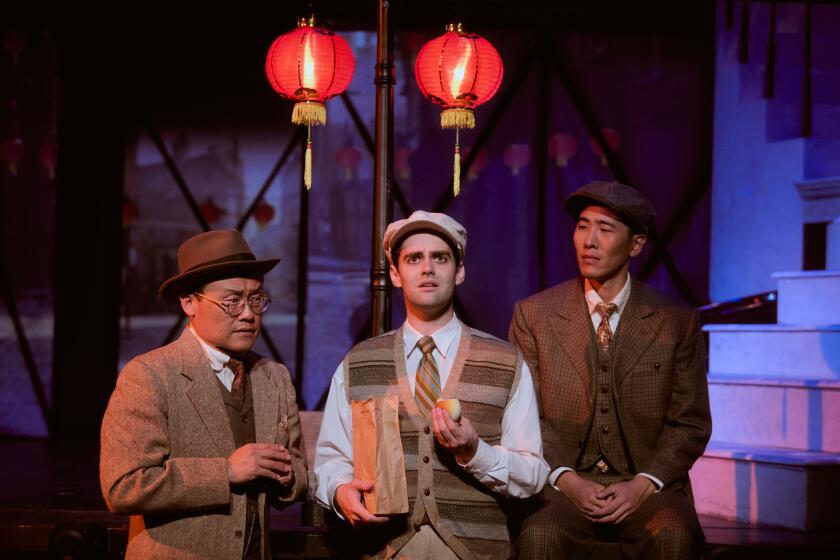Quintessentially L.A.
“I drove around for 20 years taking pictures of these things. Finally, someone told me, ‘You’ve got to make a book.’ ” So says graphic designer Clive Piercy, who has lived in Los Angeles for two decades, which is precisely how long it has taken him to publish his first book of photographs.
A paean to the dingbat, the stucco-box apartment house that was the go-to form of residential architecture in Los Angeles from the 1950s to the 1970s and still lines many of its streets, Piercy’s book began gestating in 1982, when he moved to L.A. from London with his wife.
As they drove around the city looking for an apartment, Piercy -- and, so he claims, his wife -- became enthralled by the ubiquitous dingbats (the name comes from the starburst feature often used for lamps on their exteriors), as many Brits fleeing the parochial stone ways of Christopher Wren have been.
“We embraced the crappiness of it,” he says. Piercy made it a point to photograph his favorite examples. The result is “Pretty Vacant: The Los Angeles Dingbat Observed,” whose 448 pages Piercy describes, with satisfaction, as “pretty bland.”
Tallish, with strands of gray and white hair hanging past his ears, the 48-year-old Piercy tends toward the collared-but-disheveled look, which fits with his eminently relaxed demeanor. He works in a high-ceilinged, eminently relaxed studio in a little industrial warren in Santa Monica, where he discussed “Pretty Vacant.” Not unlike a new Radiohead album, several encounters are required to get used to the book, and meeting its maker helps.
Piercy knew he wanted to be an artist at age 11, when he first glimpsed the cover of the Beatles’ album “Sgt. Pepper’s Lonely Hearts Club Band.” He began his career designing titles for the BBC. He came here to work for commercial designer Rod Dyer, one of the stars of the West Coast style of graphics (think silken Warhol lines and spare, bright colors), as everyone was excitedly calling it then.
Living the American pop culture-obsessed Brit’s dream, he designed movie posters and album covers, including those for the Michael Mann film “Manhunter” and for Elton John’s “Too Low for Zero.” Now, Piercy is half of the design house PhD, which he runs with partner Michael Hodgson, yet another London emigre.
To call “Pretty Vacant” a celebration of the dingbat, even a study of it, would be inaccurate. It’s more a meditation, in the most literal sense of the word. Flipping through the flat, monochromatic photographs of nondescript building after nondescript building, you fall into a kind of trance, until you almost feel as though you’re driving up and down the streets of Palms and West Hollywood, looking for “for rent” signs. Of course, this is exactly what Piercy wants.
“When I used print film, I sometimes didn’t develop the rolls for months on end,” he says, flipping through the book, looking rather entranced himself. He stares quizzically at one photo: “I have no bloody idea where some of this stuff is.”
Piercy says the book is in part a tribute to the early 1960s work of artist Ed Ruscha (yet another emigre, albeit from Oklahoma), particularly his books of photographs, whose titles explained exactly what was inside. There is one called “Twenty Six Gasoline Stations” and “Thirty Four Parking Lots in Los Angeles.” Piercy’s favorite is “Every Building on the Sunset Strip,” which shows every building on the Sunset Strip.
Does Piercy think it’s easier to appreciate dingbats if you’re not from L.A.? “Yes,” he says. “It takes a certain odd taste to like them. I know just enough about architecture to be dangerous.” But he insists that the dingbat has its place in architectural history. “They have a connection to Le Corbusier and the International style,” he says. “Some of them -- the purist ones -- are pretty amazing. They really are just stucco boxes. Gorgeous! They’re pure design.”
Has he ever lived in a dingbat?
“No,” Piercy admits. “They’re kind of pokey.” Their pokiness included, Piercy gushes over dingbats with an enthusiasm that only a person raised among medieval buildings could. (He grew up in a small town in the Cotswolds region of western England.) He describes them variously as “gorgeous,” “amazing,” “terrific.”
“This one has an almost crusader touch about it,” he says, pointing to a blank white exterior broken up only by a haphazardly placed window and a kind of debased coat of arms ornament below it. He’s especially fond of the dingbats that aspire, with just the slightest effort, to acquire some touch of European elegance.
“It’s like they couldn’t quite take it all the whole purist way,” he says, pointing to an otherwise featureless wall above a carport that’s pocked on either side with minute carriage lamps. Grandiose names -- manors, arms, chezs, chateaus -- abound.
“How charming is that?” Piercy asks, flipping to a big, numb box with Byron Arms printed above the doorway. “Nobody in their right mind would think that Lord Byron lived there. It’s lovely!”
He’s also very pleased when the buildings’ owners seem to want to pay homage to a loved one. He flips to a wall of fake wood siding with “Shari Romaine” in block letters nailed to it.
“I know this is probably on Romaine Street, but I like to think there’s a woman named Shari Romaine.” Across the page is a dingbat that calls itself the Monica Palms. “And she’s friends with Monica Palms.”
After one peruses “Pretty Vacant” for a while, Piercy’s dingbat infatuation can become infectious. On their tabula rasa facades, the smallest ornamentations seem to amount to colossal statements. You begin scanning the white stucco for glitches in the matrix, and every one seems a discovery -- a yellow plaster diamond! An oversize address sign!
Look closer, and Los Angeles’ postwar history and its waves of immigration seem to make themselves felt. Asia and the Pacific pop up in tiki-pattern screens and muted pagoda archways; Eastern Europe, in the utilitarian blocks and raw metal window frames; even, Piercy will tell you, cheap horror movies and doo-wop Cadillacs, in the occasional oversize dingbat light fixture crawling up a wall or a chrome racing stripe stretching across it. Your imagination? His? Perhaps. But then, what drives L.A. but imagination?
Indeed, the dingbat might take as much inspiration from B-movie sets and the dreams of the highway as it does from Le Corbusier, Piercy admits. He sums up his love of such things: “You can like a Pinto as much as you like a Ferrari.”
James Verini can be contacted at weekend@latimes.com.
*
Pretty Vacant: The Los Angeles Dingbat Observed
Photographer: Clive Piercy
Publisher: Chronicle Books, $24.95
(448 pp.)
Info: Available at art and independent bookstores or at www.chroniclebooks.com
More to Read
Sign up for our Book Club newsletter
Get the latest news, events and more from the Los Angeles Times Book Club, and help us get L.A. reading and talking.
You may occasionally receive promotional content from the Los Angeles Times.






